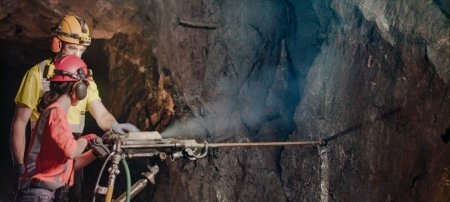Simple Design Equals Smaller Footprint: Rail-Veyor System for Mining (and More?)

As the video begins, what appears to be a roller coaster approaches in slow motion: a green tube traveling along bright yellow tracks. As the object moves closer, it becomes a modernistic train with no driver and unloads rock into a container, turning upside down in the process. Then, it rights itself, ready to receive another load of iron ore, or coal, or anything.
According to its creator, Mike Dibble ’61/’62, this remote-controlled, electric-powered “Rail-Veyor” system can operate in surface and underground mines or other long-distance transfer operations, including docks, shipyards.
Dibble’s company, Rail-Veyor Systems Inc., had its original demo built in Florida. After the system began to be commercialized, a second, larger-scale demo was built in South Africa, where the first commercial operation began in 2007. Now there are three trains operating there, all hauling gold ore.
In the Rail-Veyor system, the train is moved along by fixed drive stations, spaced slightly less than the length of the individual trains, (some 100 to 400 meters in length). All Rail-Veyor cars are driven forward from the friction of horizontally rotated truck tires. (To see how this works, view the slide show, above.)
“It is this drive system that allows the Rail-Veyor to climb grades of 20 percent
or more,” Dibble says. Conventional rail systems are limited to 1 to 1.5 percent grades.
“The track system can be operated as a shuttle or a continuous loop. Anchored by the
drive stations, it eliminates the need for conventional, heavier railroad track systems,”
he says. “Since there’s no heavy drive car, the track loading is low, allowing the
use of lightweight rails.”
The connections between cars allow articulated movement between them, Dibble says. The ability to climb steep grades with a 30-meter turning radius, coupled with a small front end, allows the system to go under, over, and easily avoid obstacles. It's also energy efficient, since the drive stations only operate when a train is present and shut down when not in use.
“The automated operations mean no direct operator intervention required,” he says. “The system is as environmentally friendly as it is quiet, has low visibility, and uses nonpolluting electrical drive motors.”
Projections by an underground mining company indicate the Rail-Veyor system can reduce
their operating costs 40 to 50 percent versus conventional shaft mining operations.
The Rail-Veyor system is maintenance friendly: so far so good in South Africa, with
three years operating and no failures.
As for safety, Dibble says the fact that the train is sneaky quiet means the lead
car should be equipped with strobes, sirens, even a transmitter to preclude any run-ins
with moose or other large creatures, wherever in the world they may occur.
And other operations are very interested. Dibble’s not saying, but there could be a day when these lean, mean hauling machines are pulling their weight around the globe, including the UP, and leaving much less behind.
Michigan Technological University is an R1 public research university founded in 1885 in Houghton, and is home to nearly 7,500 students from more than 60 countries around the world. Consistently ranked among the best universities in the country for return on investment, Michigan's flagship technological university offers more than 185 undergraduate and graduate degree programs in science and technology, engineering, computing, forestry, business, health professions, humanities, mathematics, social sciences, and the arts. The rural campus is situated just miles from Lake Superior in Michigan's Upper Peninsula, offering year-round opportunities for outdoor adventure.




Comments